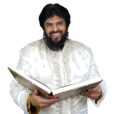THE QUR'AN
[ALLAH PRESERVED IT]
إِنَّا نَحۡنُ نَزَّلۡنَا ٱلذِّكۡرَ وَإِنَّا لَهُ ۥ لَحَـٰفِظُونَ (٩)
Surah Al-Hijr
Verily We: It is We Who have sent down the Dhikr (i.e. the Qur’ân) and surely, We will guard it (from corruption)(9)
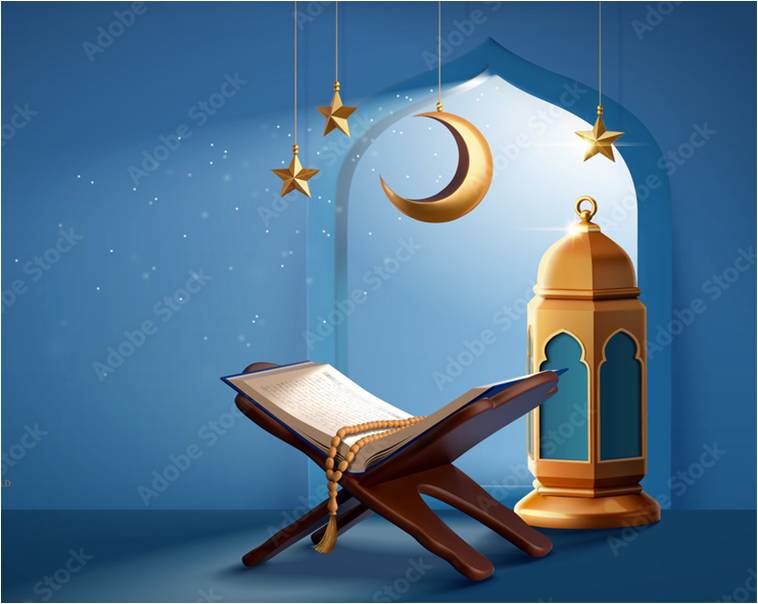
MIRACLES OF QUR'AN
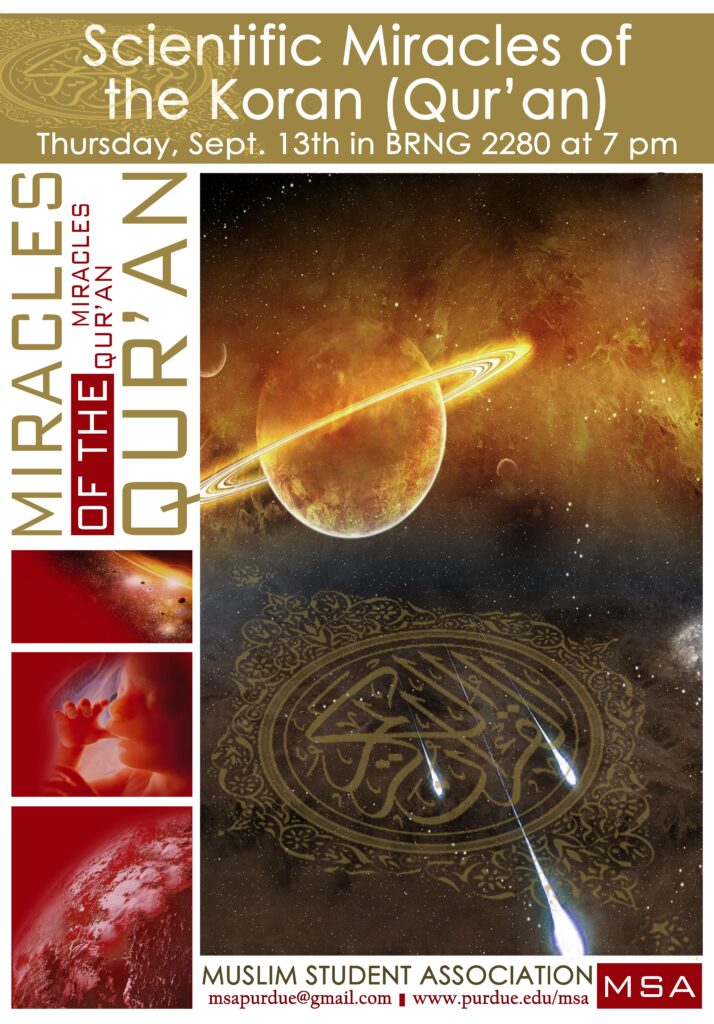
INTRODUCTION TO THE MIRACLES OF THE HOLY QUR’AN
سُوۡرَةُ فَاطِر
وَمِنَ ٱلنَّاسِ وَٱلدَّوَآبِّ وَٱلۡأَنۡعَـٰمِ مُخۡتَلِفٌ أَلۡوَٲنُهُ ۥ كَذَٲلِكَۗ إِنَّمَا يَخۡشَى ٱللَّهَ مِنۡ عِبَادِهِ ٱلۡعُلَمَـٰٓؤُاْۗ إِنَّ ٱللَّهَ عَزِيزٌ غَفُورٌ (٢٨)
Surah Fatir
{And so amongst men and crawling creatures and cattle, are they of various colours. Those truly fear Allah, among His Servants who have knowledge: for Allah is Exalted in Might, Oft-Forgiving. (28)
Surah Fatir (Chapter 35), verse 28 emphasizes the diversity in the creation of human beings, crawling creatures, and cattle. The verse underscores the variation in colours among these creatures as a manifestation of the creative power of Allah. It further highlights that those who truly fear Allah among His servants are those endowed with knowledge. The verse concludes by reminding that Allah is Exalted in Might and Oft-Forgiving. The tafsir (exegesis or interpretation) of this verse can be understood in the following manner:
Diversity in Creation:
The mention of diverse colours among humans, crawling creatures, and cattle emphasizes the richness and variety in Allah’s creation. This diversity is a reflection of His wisdom and creative power.
Significance of Colours:
The colours in creation signify the beauty and complexity of Allah’s design. They serve as a reminder for humans to reflect on the signs of Allah in the world around them.
Fear of Allah and Knowledge:
The verse associates the fear of Allah with knowledge. This indicates that true piety and mindfulness of Allah come through understanding and awareness. Knowledge here is not just factual information but a deep understanding of the divine and the wisdom behind creation.
The Role of Knowledge in God-Consciousness:
The verse suggests that those who possess knowledge are more likely to fear Allah sincerely. This is because understanding the attributes of Allah, His creation, and His guidance fosters a profound sense of reverence and awe.
Allah’s Might and Forgiveness:
The verse concludes by highlighting two attributes of Allah: His Might (Aziz) and His Forgiveness (Ghafur). Allah’s Might signifies His sovereignty and control over all aspects of creation, while His Forgiveness emphasizes His mercy and willingness to pardon the shortcomings of His servants.
In summary, Surah Fatir,verse 28, invites believers to contemplate the diversity in Allah’s creation, recognize the connection between true piety and knowledge, and acknowledge Allah’s attributes of Might and Forgiveness. It serves as a reminder to approach life with humility, gratitude, and a deep understanding of the signs of Allah in the world.
سُوۡرَةُ یُونس
قُلِ ٱنظُرُواْ مَاذَا فِى ٱلسَّمَـٰوَٲتِ وَٱلۡأَرۡضِۚ وَمَا تُغۡنِى ٱلۡأَيَـٰتُ وَٱلنُّذُرُ عَن قَوۡمٍ۬ لَّا يُؤۡمِنُونَ (١٠١)
Surah Yunus
Say: “Behold all that is in the heavens and on earth”; but neither Signs nor Warners profit those who believe not. (101)
Surah Yunus (Chapter 10) is part of the Quran, the holy book of Islam. The verse is Ayah 101,
Surah Yunus (10:101): “Say: ‘Behold all that is in the heavens and on earth’; but neither Signs nor Warners profit those who believe not.”
Tafsir:
In this verse, Allah instructs the Prophet Muhammad (peace be upon him) to invite people to reflect upon the signs and creations of he heavens and the earth. The call to “say” indicates that this is a message to be conveyed to the people. The command to look at what is in the heavens and on the earth implies a reflection on the natural world, the celestial bodies, and the earthly creations.
Reflecting on the Signs:
The verse encourages believers to ponder over the signs of Allah’s creation. The heavens and the earth contain numerous signs that point towards the existence, wisdom, and power of the Creator.
This reflection is not limited to a mere observation of the physical world but extends to understanding the purpose and significance behind the creation.
Ineffectiveness for Disbelievers: The verse emphasizes that these signs and warnings will not benefit those who choose not to believe. The signs of Allah, evident in the natural world and conveyed through the messages of prophets, are intended to guide and awaken the hearts of those who are open to belief.
However, for those who reject faith, no amount of signs or warnings will bring about a change in their beliefs unless they choose to accept the guidance.
The Role of Signs and Warners:
Signs (Ayat) refer to the various miracles, phenomena, and manifestations of Allah’s power in the universe.
Warners (Nudhur) are the prophets and messengers who conveyed the message of Allah to humanity, warning them of the consequences of disbelief and the rewards of faith.
The Importance of Faith:
The verse underscores the significance of faith in recognizing and benefiting from the signs of Allah. Faith opens the heart to understanding and appreciating the purpose behind creation, and it enables a person to heed the warnings and guidance provided by God through His messengers.
In summary, Surah Yunus (10:101) encourages reflection on the signs in the heavens and the earth, emphasizing that these signs and warnings are ineffective for those who choose not to believe. It underscores the importance of faith in recognizing the divine purpose behind creation and heeding the guidance of the messengers.
سُوۡرَةُ العَنکبوت
قُلۡ سِيرُواْ فِى ٱلۡأَرۡضِ فَٱنظُرُواْ ڪَيۡفَ بَدَأَ ٱلۡخَلۡقَۚ ثُمَّ ٱللَّهُ يُنشِئُ ٱلنَّشۡأَةَ ٱلۡأَخِرَةَۚ إِنَّ ٱللَّهَ عَلَىٰ ڪُلِّ شَىۡءٍ۬ قَدِيرٌ۬ (٢٠)
Surah Al-Ankaboot
Say: “Travel through the earth and see how Allah did originate creation: so will Allah produce a later creation: for Allah has power over all things. (20)
Surah Al-Ankaboot, the 29th chapter of the Quran, is named after the spider (Al-Ankaboot in Arabic) mentioned in verse 41. It is a Meccan surah and comprises 69 verses. The verse is Ayah 20: Translation: “Say, ‘Travel through the earth and see how Allah did originate creation: so will Allah produce a later creation: for Allah has power over all things.'” (29:20)
Tafsir (Interpretation): In this verse, Allah instructs Prophet Muhammad (peace be upon him) to invite people to reflect upon the signs of creation present in the world around them. The command to “travel through the earth” implies observation, contemplation, and exploration of the natural world. Allah encourages humanity to study the diverse landscapes, ecosystems, and the countless creatures and plants that inhabit the Earth.
The second part of the verse, “so will Allah produce a later creation,” points to the concept of resurrection and the recreation of life after death. It suggests that just as Allah brought the initial creation into existence, He has the power and capability to bring forth a new creation in the Hereafter. This serves as a reminder of the ultimate reality of life after death and the Day of Judgement.
The concluding statement, “for Allah has power over all things,” emphasizes Allah’s absolute authority and control over the entire universe. It reaffirms His ability to create, recreate, and manage all affairs. The verse serves as an invitation to reflect on the signs of Allah’s creation, acknowledge His power, and prepare for the accountability of the Hereafter.
In summary, Surah Al-Ankaboot, through this verse, encourages contemplation of the natural world as a means to recognize the Creator’s wisdom and power, and it emphasizes the concept of resurrection and the divine ability to bring forth a new creation in the Hereafter.
The Quran is considered by Muslims to be the literal word of Allah as revealed to Prophet Muhammad. Various verses in the Quran are often considered miraculous, and Muslims believe that the Quran contains many signs and proofs of its divine origin.
Here are a few examples:
Scientific Miracles: Reference:
Quran 21:30 (Surah Al-Anbiya, 21:30) Arabic:
أَوَلَمْ يَرَ الَّذِينَ كَفَرُوا أَنَّ السَّمَاوَاتِ وَالْأَرْضَ كَانَتَا رَتْقًا فَفَتَقْنَاهُمَا ۖ وَجَعَلْنَا مِنَ الْمَاءِ كُلَّ شَيْءٍ حَيٍّ ۖ أَفَلَا يُؤْمِنُونَ
English:
Do not those who disbelieve see that the heavens and the earth were a closed-up mass, then We opened them out? And We made from water every living thing. Will they not then believe?
Embryology:
Reference: Quran 23:13-14 (Surah Al-Mu’minun, 23:13-14) Arabic:
ثُمَّ خَلَقْنَا النُّطْفَةَ عَلَقَةً فَخَلَقْنَا الْعَلَقَةَ مُضْغَةً فَخَلَقْنَا الْمُضْغَةَ عِظَامًا فَكَسَوْنَا الْعِظَامَ لَحْمًا ثُمَّ أَنشَأْنَاهُ خَلْقًا آخَرَ ۚ فَتَبَارَكَ اللَّهُ أَحْسَنُ الْخَالِقِينَ
English:
Then We made the sperm-drop into a clinging clot, and We made the clot into a lump [of flesh], and We made [from] the lump, bones, and We covered the bones with flesh; then We developed him into another creation. So blessed is Allah, the best of creators.
Mountains as Pegs/Stabilizers:
Reference:
Quran 78:6-7 (Surah An-Naba, 78:6-7) Arabic:
أَلَمْ نَجْعَلِ الْأَرْضَ كِفَاتًا وَالْجِبَالَ أَوْتَادًا وَخَلَقْنَاكُمْ أَزْوَاجًا
English:
Have We not made the earth as a bed and the mountains as pegs, and created you in pairs?
These examples are often cited as miraculous because, at the time of the Quranic revelation, the scientific knowledge necessary to understand these phenomena was not available. However, some argue that these verses are open to interpretation, and discussions on these topics may vary among scholars and researchers. Interpretations and understanding of these verses can also be influenced by individual beliefs and perspectives.
MIRACLES OF QUR'AN-1- BARRIER BETWEEN BETWEEN SALTY AND SWEET WATER
1- BARRIER BETWEEN BETWEEN SALTY AND SWEET WATER.
سُوۡرَةُ الرَّحمٰن
مَرَجَ ٱلۡبَحۡرَيۡنِ يَلۡتَقِيَانِ (١٩) بَيۡنَہُمَا بَرۡزَخٌ۬ لَّا يَبۡغِيَانِ (٢٠)
Surah Ar-Rahman
He has let free the two bodies of flowing water, meeting together: (19) Between them is a Barrier which they do not transgress: (20)
1- BARRIER BETWEEN BETWEEN SALTY AND SWEET WATER.
سُوۡرَةُ الرَّحمٰن
مَرَجَ ٱلۡبَحۡرَيۡنِ يَلۡتَقِيَانِ (١٩) بَيۡنَہُمَا بَرۡزَخٌ۬ لَّا يَبۡغِيَانِ (٢٠)
Surah Ar-Rahman
He has let free the two bodies of flowing water, meeting together: (19) Between them is a Barrier which they do not transgress: (20)
MIRACLES OF QUR'AN
2-LAYERS OF THE SEAS AND RIVERS
MIRACLES OF QUR’AN
2-LAYERS OF THE SEAS AND RIVER
2-LAYERS OF THE SEAS AND RIVERS
2-LAYERS OF THE SEAS AND RIVERS
MIRACLES OF QUR'AN
3 - FIRE KINDLED THE SEA
MIRACLES OF QUR’AN
3 – FIRE KINDLED THE SEA
3 – FIRE KINDLED THE SEA
3 – FIRE KINDLED THE SEA
MIRACLES OF QUR'AN
4 - ASTRONOMY IN THE QUR'AN
4 – ASTRONOMY IN THE QUR’AN
4 – ASTRONOMY IN THE QUR’AN
4 – ASTRONOMY IN THE QUR’AN
MIRACLES OF THE HOLY QUR'AN
5 - THE LACK OF OXYGEN
5 – THE LACK OF OXYGEN
5 – THE LACK OF OXYGEN
5 – THE LACK OF OXYGEN
MIRACLES OF QUR'AN
6 THE EARTH AND THE SKIES WERE GATHERED IN ONE MASS
6 THE EARTH AND THE SKIES WERE GATHERED IN ONE MASS
6 THE EARTH AND THE SKIES WERE GATHERED IN ONE MASS
6 THE EARTH AND THE SKIES WERE GATHERED IN ONE MASS
MIRACLES OF QUR'AN
7 - THE UNIVERSE IS MOVING AND EXPANDING
MIRACLES OF QUR'AN
8 - THE SUNSHINE AND THE MOONLIGHT
MIRACLES OF QUR'AN
9 - THE KNOCKING STAR
9 – THE KNOCKING STAR
9 – THE KNOCKING STAR
9 – THE KNOCKING STAR
MIRACLES OF THE HOLY QUR'AN
10 - THE SWEEPING STARS
10 – THE SWEEPING STARS
10 – THE SWEEPING STARS
10 – THE SWEEPING STARS
MIRACLES OF QUR'AN
11 - PLAN TO PLANE
11 – PLAN TO PLANE
11 – PLAN TO PLANE
11 – PLAN TO PLANE
MIRACLES OF THE QUR'AN
12 - ALLAH CREATES THINGS OF WHICH YOU HAVE NO KNOWLEDGE
12 – ALLAH CREATES THINGS OF WHICH YOU HAVE NO KNOWLEDGE
12 – ALLAH CREATES THINGS OF WHICH YOU HAVE NO KNOWLEDGE
12 – ALLAH CREATES THINGS OF WHICH YOU HAVE NO KNOWLEDGE
MIRACLES OF THE HOLY QUR'AN
13 - YOU THINK THEM SOLID
13 – YOU THINK THEM SOLID
13 – YOU THINK THEM SOLID
13 – YOU THINK THEM SOLID
MIRACLES OF QUR'AN
14 - THE SUN'S BRIGHTNESS
14 – THE SUN’S BRIGHTNESS
14 – THE SUN’S BRIGHTNESS
14 – THE SUN’S BRIGHTNESS
MIRACLES OF THE HOLY QUR'AN

1- THE BIG BANG THEORY IN THE HOLY QUR'AN
سُوۡرَةُ الاٴنبیَاء
أَوَلَمۡ يَرَ ٱلَّذِينَ كَفَرُوٓاْ أَنَّ ٱلسَّمَـٰوَٲتِ وَٱلۡأَرۡضَ ڪَانَتَا رَتۡقً۬ا فَفَتَقۡنَـٰهُمَاۖ وَجَعَلۡنَا مِنَ ٱلۡمَآءِ كُلَّ شَىۡءٍ حَىٍّۖ أَفَلَا يُؤۡمِنُونَ (٣٠)
Surah Al-Anbiya
Do not the Unbelievers see that the heavens and the earth were joined together (as one unit of Creation), before We clove them asunder? We made from water every living thing. Will they not then believe? (30)
Let’s break down the verse:
أَوَلَمۡ يَرَ ٱلَّذِينَ كَفَرُوٓاْ أَنَّ ٱلسَّمَـٰوَٲتِ وَٱلۡأَرۡضَ ڪَانَتَا رَتۡقً۬ا فَفَتَقۡنَـٰهُمَاۖ
“Do not the Unbelievers see that the heavens and the earth were joined together (as one unit of Creation), before We clove them asunder?”
This part of the verse addresses the unbelievers, questioning whether they do not see or reflect upon the state of the heavens and the earth before their separation. The term “ratq” refers to a closeness or a joining together.
وَجَعَلۡنَا مِنَ ٱلۡمَآءِ كُلَّ شَىۡءٍ حَىٍّۖ
“We made from water every living thing.”
This part emphasizes the role of water in the creation of every living thing. It is a reminder of the significance of water as a fundamental element in the creation and sustenance of life.
أَفَلَا يُؤۡمِنُونَ
“Will they not then believe?”
The verse concludes with a rhetorical question, inviting reflection on the signs of Allah’s creation and questioning why the unbelievers do not believe in the divine power and wisdom evident in these signs.
In summary, this verse highlights the oneness of the original creation, the subsequent separation of the heavens and the earth, and the role of water in the creation of life, inviting contemplation and belief in the Creator.
MIRACLES OF THE HOLY QUR'AN
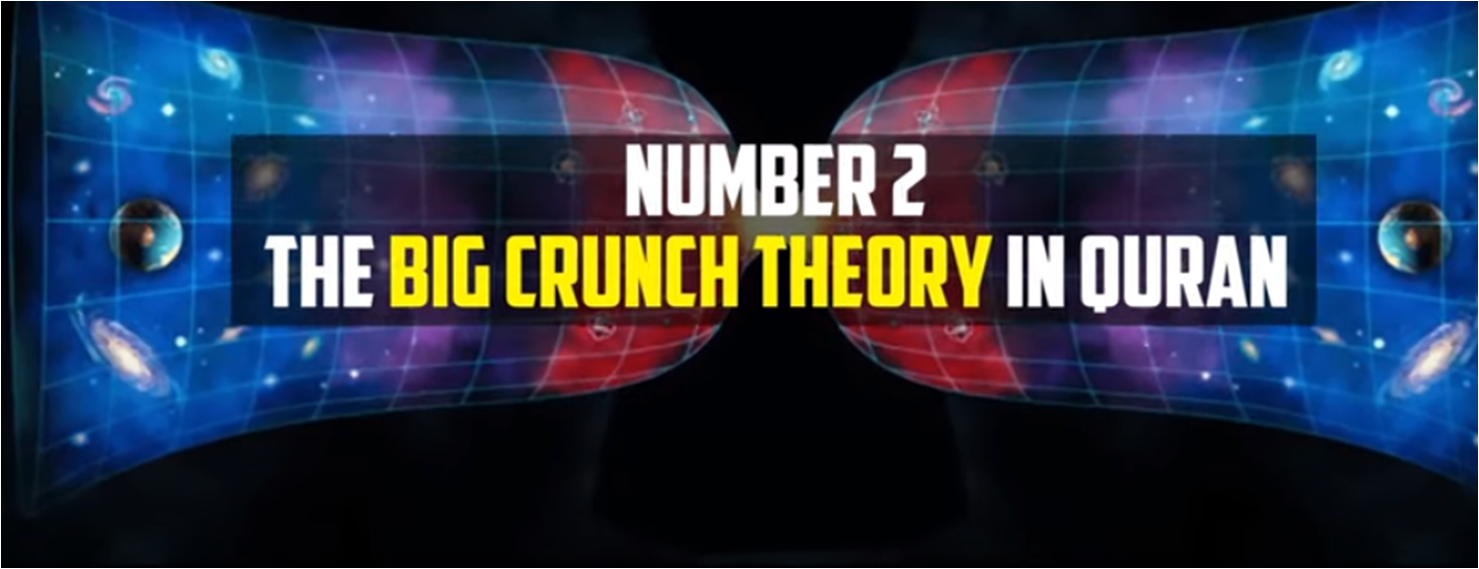
2- THE BIG CRUNCH THEORY IN THE HOLY QUR'AN
HOW THE UNIVERSE WILL END
GENERAL RELATIVITY THEORY
سُوۡرَةُ المؤمنون
وَلَقَدۡ خَلَقۡنَا ٱلۡإِنسَـٰنَ مِن سُلَـٰلَةٍ۬ مِّن طِينٍ۬ (١٢) ثُمَّ جَعَلۡنَـٰهُ نُطۡفَةً۬ فِى قَرَارٍ۬ مَّكِينٍ۬ (١٣) ثُمَّ خَلَقۡنَا ٱلنُّطۡفَةَ عَلَقَةً۬ فَخَلَقۡنَا ٱلۡعَلَقَةَ مُضۡغَةً۬ فَخَلَقۡنَا ٱلۡمُضۡغَةَ عِظَـٰمً۬ا فَكَسَوۡنَا ٱلۡعِظَـٰمَ لَحۡمً۬ا ثُمَّ أَنشَأۡنَـٰهُ خَلۡقًا ءَاخَرَۚ فَتَبَارَكَ ٱللَّهُ أَحۡسَنُ ٱلۡخَـٰلِقِينَ (١٤)
Surah Al-Mumenoon
Man We did create from a quintessence (of clay); (12) Then We placed him as (a drop of) sperm in a place of rest firmly fixed; (13) Then We made the sperm into a clot of congealed blood; then of that clot We made a (foetus) lump; then We made out of that lump bones and clothed the bones with flesh; then We developed out of it another creature: so blessed be Allah, the Best to create! (14)
The passage is from Surah Al-Anbiya (Chapter 21), specifically verse 104. This verse describes a significant event that will take place on the Day of Judgment. The imagery used in the verse is powerful and metaphorical, emphasizing the absolute control of Allah over the heavens and the unfolding of cosmic events.
Let’s break down the key elements of the verse:
The Day of Judgment:
The verse refers to a future event, “Yawm” (Day), which is understood in Islamic theology as the Day of Judgment. It is a day when all individuals will be resurrected and held accountable for their deeds. Rolling up the Heavens:
The metaphorical language of “rolling up the heavens like a scroll” conveys the idea of a dramatic and cataclysmic transformation. The imagery is reminiscent of rolling up a scroll or a parchment, suggesting the folding and unveiling of cosmic phenomena.
Comparison to the First Creation:
The verse draws a parallel between the rolling up of the heavens on the Day of Judgment and the initial creation of the universe. This comparison highlights the power and capability of Allah to bring about both the original creation and its subsequent renewal.
Promise and Fulfillment: The verse concludes with the assertion that this event is a promise made by Allah, and it will undoubtedly be fulfilled. This emphasizes the certainty of divine promises and the inevitability of the Day of Judgment.
The overall message of the verse is to remind believers of the ultimate authority of Allah over the heavens and the earth, emphasizing His ability to recreate the universe just as He created it initially. It serves as a call to reflect on the transient nature of this world and the importance of preparing for the Hereafter.
MIRACLES OF THE HOLY QUR'AN

3- EMBRYOLOGY IN THE HOLY QUR'AN
سُوۡرَةُ المؤمنون
وَلَقَدۡ خَلَقۡنَا ٱلۡإِنسَـٰنَ مِن سُلَـٰلَةٍ۬ مِّن طِينٍ۬ (١٢) ثُمَّ جَعَلۡنَـٰهُ نُطۡفَةً۬ فِى قَرَارٍ۬ مَّكِينٍ۬ (١٣) ثُمَّ خَلَقۡنَا ٱلنُّطۡفَةَ عَلَقَةً۬ فَخَلَقۡنَا ٱلۡعَلَقَةَ مُضۡغَةً۬ فَخَلَقۡنَا ٱلۡمُضۡغَةَ عِظَـٰمً۬ا فَكَسَوۡنَا ٱلۡعِظَـٰمَ لَحۡمً۬ا ثُمَّ أَنشَأۡنَـٰهُ خَلۡقًا ءَاخَرَۚ فَتَبَارَكَ ٱللَّهُ أَحۡسَنُ ٱلۡخَـٰلِقِينَ (١٤)
Surah Al-Mumenoon
Man We did create from a quintessence (of clay); (12) Then We placed him as (a drop of) sperm in a place of rest firmly fixed; (13) Then We made the sperm into a clot of congealed blood; then of that clot We made a (foetus) lump; then We made out of that lump bones and clothed the bones with flesh; then We developed out of it another creature: so blessed be Allah, the Best to create! (14)
Let’s break down the meaning of these verses:
“Man We did create from a quintessence (of clay);” (Quran 23:12)
This verse acknowledges the creation of human beings from a quintessence or essence of clay. It signifies the origin of humanity from humble materials.
“Then We placed him as (a drop of) sperm in a place of rest firmly fixed;” (Quran 23:13)
The verse describes the next stage of human development where the created human is placed as a drop of sperm in a secure and firmly fixed place, indicating the beginning of the process of human reproduction.
“Then We made the sperm into a clot of congealed blood; then of that clot We made a (foetus) lump;” (Quran 23:14)
These verses describe the transformation of the sperm into a clot of congealed blood and then into a lump or a clot of flesh, symbolizing the early stages of embryonic development.
“Then We made out of that lump bones and clothed the bones with flesh; then We developed out of it another creature:” (Quran 23:14)
The verses continue to depict the gradual development of the embryo. The lump of flesh is shaped into bones, and then flesh covers the bones, forming a complete body. The term “another creature” emphasizes the miraculous nature of the creation of a human being.
“So blessed be Allah, the Best to create!” (Quran 23:14)
The passage concludes with a declaration of the greatness of Allah as the Creator. It is an acknowledgment of the divine wisdom and perfection in the creation of human beings.
Overall, these verses highlight the miraculous and intricate process of human creation, emphasizing the power and wisdom of Allah as the ultimate Creator. The sequence of development described aligns with modern embryological knowledge, reflecting a harmonious blend of faith and science.
MIRACLES OF THE HOLY QUR'AN

4 - OCEANIC DIVISION MENTIONS IN THE HOLY QUR'AN
CONFLEX
TEMPERATURE
COLOUR
DENSITY
سُوۡرَةُ الرَّحمٰن
مَرَجَ ٱلۡبَحۡرَيۡنِ يَلۡتَقِيَانِ (١٩) بَيۡنَہُمَا بَرۡزَخٌ۬ لَّا يَبۡغِيَانِ (٢٠)
Surah Ar-Rahman
He has let free the two bodies of flowing water, meeting together: (19) Between them is a Barrier which they do not transgress: (20)
سُوۡرَةُ الرَّحمٰن
مَرَجَ ٱلۡبَحۡرَيۡنِ يَلۡتَقِيَانِ (١٩) بَيۡنَہُمَا بَرۡزَخٌ۬ لَّا يَبۡغِيَانِ (٢٠)
Translation:
“He has let free the two bodies of flowing water, meeting together: (19) Between them is a Barrier which they do not transgress: (20)”
This passage is often interpreted as a reference to the meeting of salty and fresh waters in the seas and oceans, with a barrier (barzakh) that separates them. The concept of a barrier suggests a natural division between the two types of water, and it is often used metaphorically in Islamic teachings to emphasize the boundaries set by Allah in the natural order of the world.
These verses are part of a larger chapter that highlights the various blessings and signs of Allah’s mercy and creation. The repetition of the refrain “Which of the favors of your Lord will you deny?” is a rhetorical question inviting reflection on the numerous blessings mentioned in the chapter.
MIRACLES OF THE HOLY QUR'AN
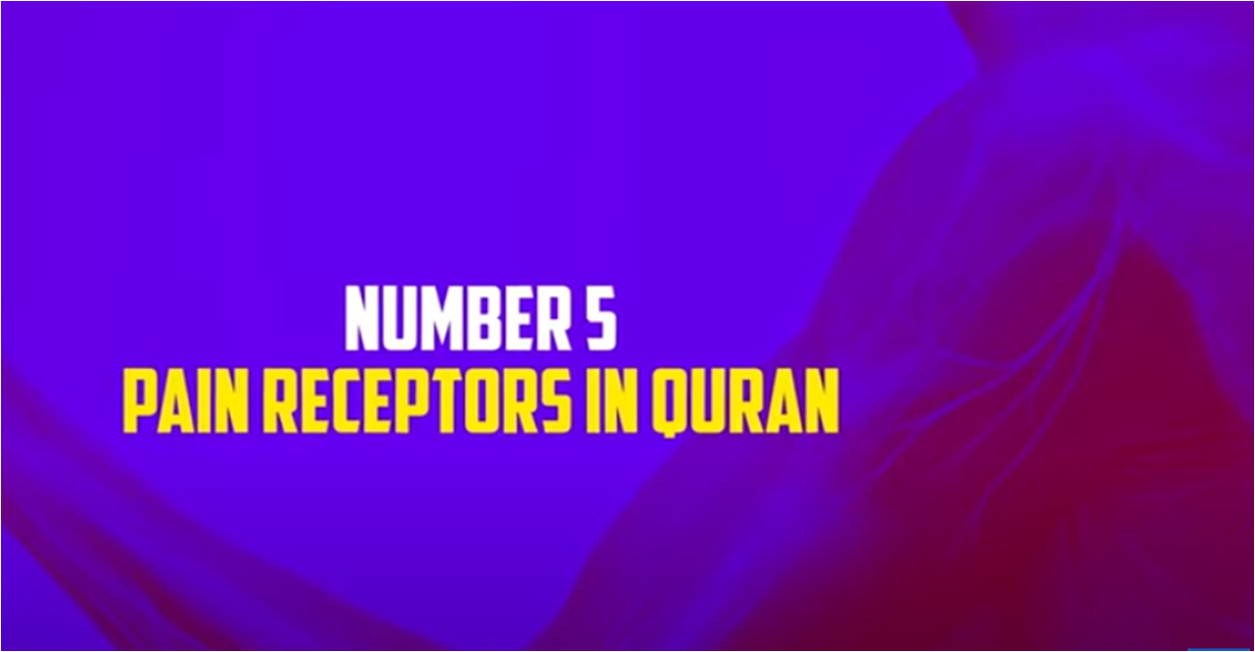
5 - PAIN RECEPTORS IN THE HOLY QUR'AN
FEATURES PAIN RECEPTORS
PAIN AND AGONY
سُوۡرَةُ النِّسَاء
إِنَّ ٱلَّذِينَ كَفَرُواْ بِـَٔايَـٰتِنَا سَوۡفَ نُصۡلِيہِمۡ نَارً۬ا كُلَّمَا نَضِجَتۡ جُلُودُهُم بَدَّلۡنَـٰهُمۡ جُلُودًا غَيۡرَهَا لِيَذُوقُواْ ٱلۡعَذَابَۗ إِنَّ ٱللَّهَ كَانَ عَزِيزًا حَكِيمً۬ا (٥٦)
Surah An-Nisa
Those who reject Our Signs We shall soon cast into the Fire: as often as their skins are roasted through, We shall change them for fresh skins, that they may taste the penalty: for Allah is Exalted in Power, Wise. (56)
The verse mentions that those who disbelieve will be cast into the Fire, and when their skins are roasted through, Allah will replace them with fresh skins so that they may continue to taste the punishment. This vivid imagery is a powerful way to convey the intensity and perpetuity of the punishment for those who reject the signs of Allah.
The verse emphasizes two attributes of Allah: His might (عَزِيزًا – ‘Aziz’) and His wisdom (حَكِيمًا – ‘Hakim’). “Exalted in Power” signifies Allah’s authority and ability to carry out His decrees, while “Wise” emphasizes the wisdom behind the punishment, indicating that it is just and serves a purpose in the divine plan.
It’s important to note that the interpretation of Quranic verses can vary, and scholars may provide different insights based on their understanding of the Arabic language, context, and other relevant factors.
Additionally, the Quran often uses metaphorical language and symbolism, so interpretations may vary among individuals and schools of thought.
MIRACLES OF THE HOLY QUR'AN

6 -INTERNAL WAVES IN THE OCEAN MENTIONED IN THE HOLY QUR'AN
سُوۡرَةُ النُّور
أَوۡ كَظُلُمَـٰتٍ۬ فِى بَحۡرٍ۬ لُّجِّىٍّ۬ يَغۡشَٮٰهُ مَوۡجٌ۬ مِّن فَوۡقِهِۦ مَوۡجٌ۬ مِّن فَوۡقِهِۦ سَحَابٌ۬ۚ ظُلُمَـٰتُۢ بَعۡضُہَا فَوۡقَ بَعۡضٍ إِذَآ أَخۡرَجَ يَدَهُ ۥ لَمۡ يَكَدۡ يَرَٮٰهَاۗ وَمَن لَّمۡ يَجۡعَلِ ٱللَّهُ لَهُ ۥ نُورً۬ا فَمَا لَهُ ۥ مِن نُّورٍ (٤٠)
Surah Al-Noor
Or (the Unbelievers' state) is like the depths of darkness in a vast deep ocean overwhelmed with billow topped by billow, topped by (dark) clouds: depths of darkness one above another: if a man stretches out his hand, he can hardly see it! For any to whom Allah giveth not light there is no light! (40)
Translation of Surah Al-Noor, Verse 40:
“Or (the Unbelievers’ state) is like the depths of darkness in a vast deep ocean overwhelmed with billow topped by billow, topped by (dark) clouds: depths of darkness one above another: if a man stretches out his hand, he can hardly see it! For any to whom Allah giveth not light there is no light!”
Explanation:
In this metaphorical description, the state of unbelievers is likened to the depths of darkness in a vast, deep ocean. The layers of darkness are compounded, symbolized by billows topped by billows and covered by dark clouds. The imagery suggests a profound and impenetrable darkness, emphasizing the depth and hopelessness of disbelief.
The mention of a person stretching out their hand and being unable to see it emphasizes the intense darkness, illustrating that even a simple act becomes challenging in such a state. This metaphorical darkness symbolizes the spiritual and moral blindness that envelops those who reject faith.
The concluding statement, “For any to whom Allah giveth not light, there is no light,” emphasizes that true enlightenment comes from Allah. Without divine guidance, people remain in spiritual darkness. This metaphor underscores the importance of seeking and receiving the light of faith from Allah to navigate the complexities of life.
As with any religious text, interpretations may vary, and it’s advisable to consult scholars and experts for a more comprehensive understanding.

